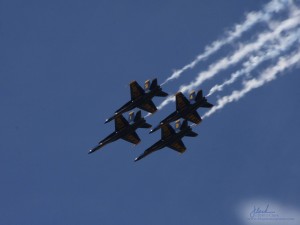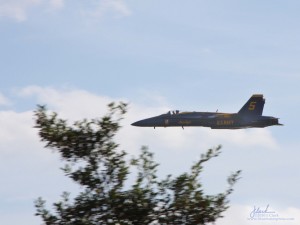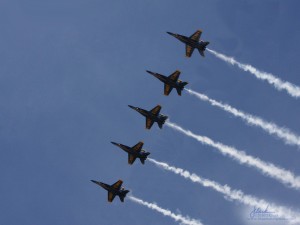I remember the first time I saw the Blue Angels. I was working the line fueling airplanes at the St. Pete-Clearwater International Airport, so I was standing atop my fuel truck. I watched the team arrive and fly their practice session and then it was time for them to land.
Surely the pilots would take separation and land individually, I thought. I watched in amazement as the flight lead brought the six-plane formation around on final in the delta formation. The four planes of the diamond formation were in their normal positions, with solo pilots in the outer positions.
As they approached the runway, the lead aircraft was in the highest point of the delta formation and the three A-4s across the back, the lowest. All six airplanes moved as one; there were six right hands manipulating flight controls, six left hands moving power control levers, and 12 boots working rudder pedals. There was, however, only one mind flying those six ships.
Standing as high on the fuel truck as I could so I could see everything, I watched the delta approach for the actual touchdown. Each airplane held position as the formation came closer to the ground. All six tires of the three rear aircraft touched the runway exactly at the same moment. Then their nosewheels touched.
Then the four mainmounts of the wingmen’s jets screamed onto the runway. A half-heartbeat later, their nosewheels slammed down. Next, Lead’s airplane came to the ground and the six airplanes were no longer flying, but rolling.
As they seemed as one in flight, so they were on the ground while rolling. It was the most impressive display of airmanship I had ever seen in my life. I suddenly realized why aviators throughout the industry referred to these guys as “the best of the best.”
Today’s Blue Angels are as skillful and as disciplined as the first team led by LCDR Roy “Butch” Voris. Voris opened the very first show of The Blues at NAS Jacksonville in June 1946 flying F6F Hellcats. Since then, only the airplanes seem to change – from the less sophisticated to more advanced. If you have the chance to see the Blue Angels fly this year, don’t miss it.
During the last weekend of October, The Blues will perform at Ft. Worth Alliance, TX and for the first weekend of November, you can catch them in Miami at the Homestead ARB. Their final performance of the year will be their homecoming at NAS Sherman Field in Pensacola, FL.
Seeing what I witnessed that day back in 1976 compelled me to compete for a seat in the fleet. It was the true job of The Blues – to spread the excitement and enthusiasm for naval aviation among the nation’s youth. To that end, they are extremely effective and successful.
The Navy charged today’s team of Blues with the same job as CDR Voris’ 1946 team. This latest team was on the job over this last weekend at NAS Jacksonville. They will repeat their performance only a few more times this year as they finish this season.
There is little doubt they convinced more than a few young men and women to compete for their own seat in the fleet.
-30-
© 2010 J. Clark





Pingback: The Blue Angels First Performance |
Pingback: The Blue Angels First Performance | joeclarksblog.com